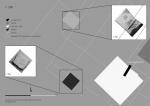Summary (English)
Within a network of roman villae the site ‘Molino San Vincenzo’ is situated in an agriculturally used region in the mid-Arno- and Pesa-valley. The excavation of 2016’s season lasted from August 23rd to September 10th 2016: Two trenches of 25 sqm (trench 3) and 30 sqm (trench 4) were examined. While trench 3 had a square-shaped layout, trench 4 was rectangular shaped. In trench 3 a concentration of pebbles mixed with fragmented tiles and ceramic vessels was discovered as the only excavation unit (US200 / S3). The pottery can be dated to the roman imperial period, however, a finding of a plastic shotgun shell demonstrates a modern intervention. In trench 4 a compact layer of gravel (thickness approx. 40 cm) was discovered (US400 / S4). This layer was vacant of anthropogenic finds. Eastwards of US400 / S4 the eventual filling of a trench (US200 / S4, US800 / S4) was excavated, characterized by refilled geological sediments up to a depth of approx. 0.68 m.
Through an enlargement of trench 4 to the east, a layer of dumped pebbles and some tile fragments of uncertain interpretation and dating was found (US700 / S4). Additionally, a circular arrangement of stones was excavated characterized by a layer of reddish earth, coal, and pieces of baked clay as well as pottery fragments (US1300 / S4). Inside this small structure a bottom of a pot was found, which is comparable with finds from Monterreggi, the villa of San Vincenzino, and the area around of Siena. Beneath of this layer the same gravels like in US400 / S4 were found.
The whole excavation has been documented completely digitally using a total station (Leica TS06plus) as well as RTK-GNSS (Leica Viva GS14), a tablet (Apple iPad mini 4), a DSLR (Nikon D7500), an action camera (GoPro HERO4 Silver) for meta-recording of the excavation process itself and various other equipment. Through an extensive use of ‘image based modeling’ methods georeferenced 3D models of every single archaeological layer were calculated.
- Veronika Schreck, M.A. - Institut für Klassische Archäologie, Universität Wien, Austria
- Dominik Hagmann, B.A. - Institut für Klassische Archäologie, Universität Wien, Austria
- Günther Schörner - Institut für Klassische Archäologie, Universität Wien, Austria
Director
- Günther Schörner-Institut für Klassische Archäologie, Universität Wien, Austria
Team
- Dominik Hagmann- Institut für Klassische Archäologie, Universität Wien, Austria
- Veronika Schreck-Institut für Klassische Archäologie, Universität Wien, Austria
Research Body
- Institut für Klassische Archäologie, Historisch-Kulturwissenschaftliche Fakultät, Universität Wien
Funding Body
- FWF
- Universität Wien






![Download [PDF]](/excavation/skins/fasti/images/results/download_sml.png)